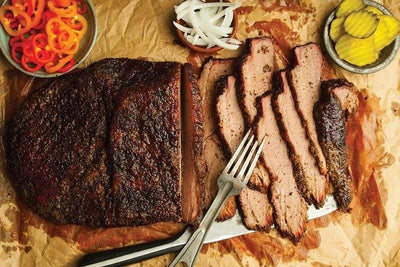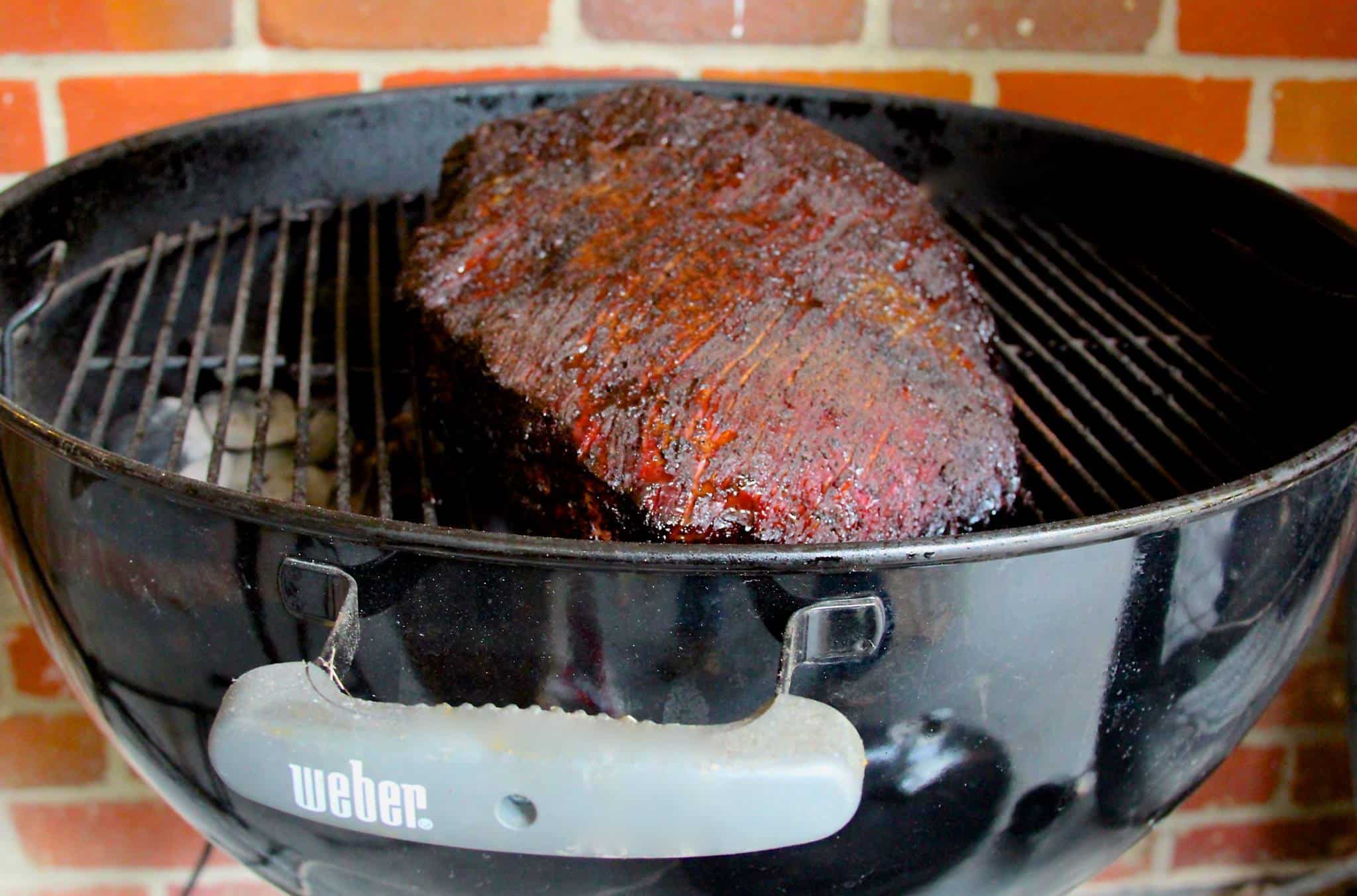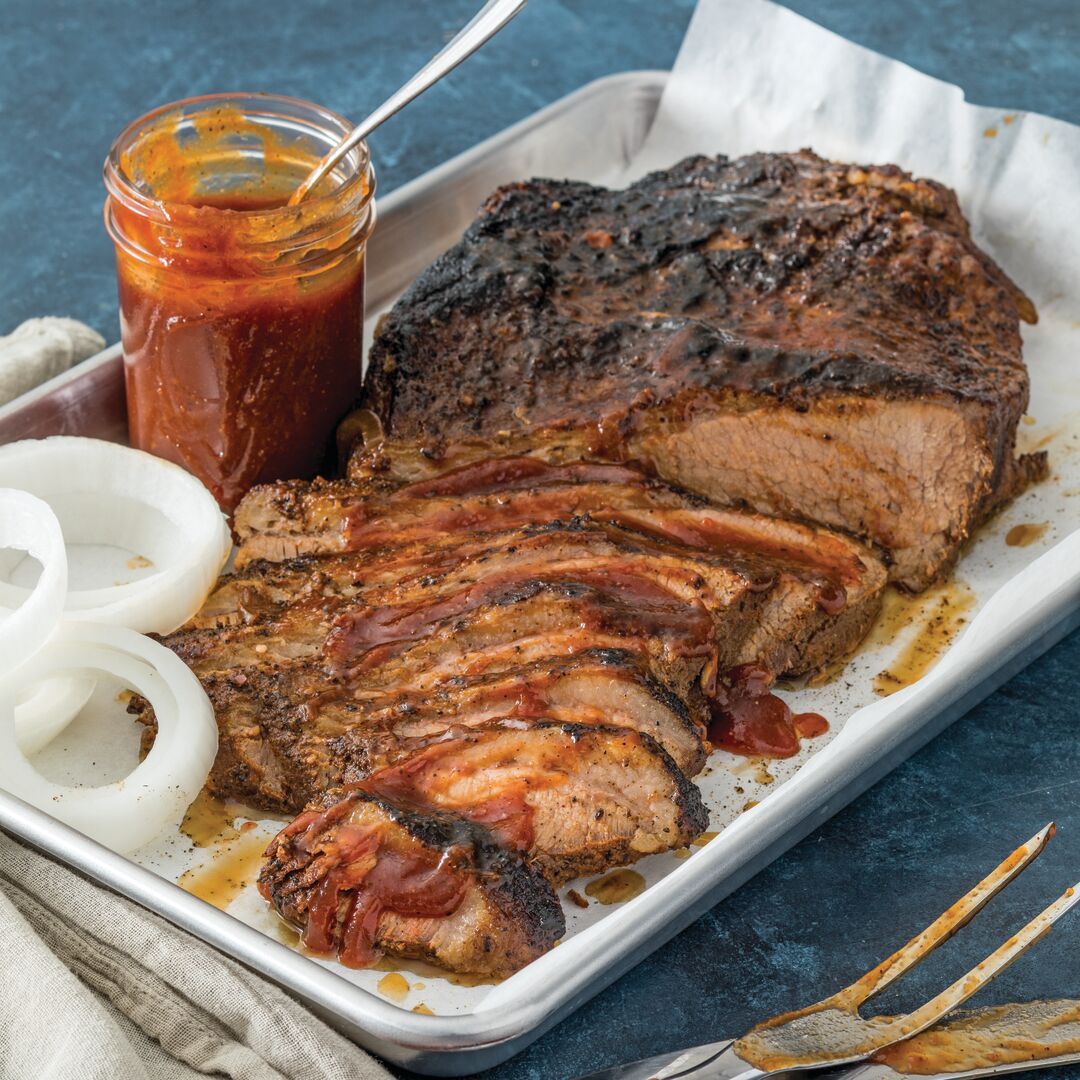
Introduction
Brisket is a popular cut of meat known for its distinctive flavor and tenderness. It is often associated with barbecue and smoked dishes, but it can also be prepared in various other ways. This blog post will explore what brisket is, its significance in cooking, and the unique flavor profile it offers.
What Is Brisket And Its Significance In Cooking
Brisket is a cut of beef that comes from the breast or lower chest of a cow. It is a large, tough muscle that supports about 60% of the cow’s bodyweight. Due to its high collagen content, brisket requires slow cooking methods to break down the tough connective tissues and achieve a tender texture.
In cooking, brisket is often braised, smoked, or barbecued to bring out its rich flavors and tenderness. It is a staple in various cuisines, including American barbecue, Jewish cuisine (where it is commonly used for making pastrami), and Tex-Mex dishes like beef fajitas. Brisket is also a popular choice for sandwiches and can be sliced thin for deli-style preparations.
The Distinct Flavor Profile Of Brisket
Brisket has a dense, savory beefy flavor similar to lean steak. When cooked properly, it becomes incredibly tender with natural juices in every bite. The texture is often compared to a fattier steak, like a ribeye, but with a unique mouthfeel. The slow cooking process allows the flavors of the natural wood used in smoking or barbecuing to infuse into the meat, adding even more depth to the taste.
When prepared on a barbecue, brisket develops a rich and smoky flavor that is deeply satisfying. The combination of the beefy taste, tenderness, and smokiness creates a luscious, savory, and robust eating experience. It’s important to note that proper cooking techniques are essential to achieve the desired flavor and texture in brisket.
In conclusion, brisket offers a one-of-a-kind taste experience that is both hearty and satisfying. Its dense savory flavor, tenderness, and the added infusion of smokiness make it a favorite among meat lovers. Whether enjoyed in traditional barbecue form or as part of a deli sandwich, brisket remains a beloved and versatile cut of meat in the culinary world.
The Anatomy Of Brisket
Understanding The Different Muscles In Brisket
Brisket is a cut of beef that is obtained from the breast or lower chest of a cow. It is made up of two main muscles: the point and the flat. The point muscle is located towards the thicker end of the brisket and is highly marbled with fat, while the flat muscle is leaner and more uniform in shape. These two muscles together make up the unique structure of brisket.
The Role Of Connective Tissue In The Flavor
Brisket is known for its connective tissue, which gives it its tough texture. This connective tissue consists mainly of collagen, a protein that breaks down during cooking to form gelatin. The gelatin adds richness and depth to the flavor of the meat. When cooked slowly over low heat, the collagen and connective tissue break down, resulting in a tender and flavorful brisket that melts in your mouth.
The connective tissue also contributes to the juiciness of the meat. As it breaks down, it releases natural juices that keep the brisket moist and succulent. This is particularly important when smoking or barbecuing brisket, as the slow cooking process allows the flavors of the natural wood to penetrate the meat, resulting in a smoky and aromatic taste.
Overall, the anatomy of brisket, with its distinct muscles and connective tissue, plays a significant role in the flavor and texture of the meat. Understanding these components can help in selecting the right cooking methods and techniques to achieve the desired tenderness and taste. Whether you’re a fan of traditional barbecued brisket or prefer other preparations, like braising or smoking, the unique composition of brisket sets it apart and makes it a favorite among meat enthusiasts.
Brisket Taste: A Beef Lover’s Delight
The Savory And Beefy Flavor Of Brisket
Brisket is a cut of beef that offers a mouthwatering taste experience. Its distinct flavor profile is a result of various factors, including the unique composition of the meat and the cooking techniques used. Here’s a closer look at what makes brisket so delicious:
- The two main muscles of brisket, the point and the flat, contribute to its flavor. The highly marbled point muscle adds richness with its generous amount of fat, while the leaner flat muscle offers a more uniform and beefy taste.
- The connective tissue in brisket plays a crucial role in enhancing its flavor. As the brisket cooks slowly, the collagen in the connective tissue breaks down, transforming into gelatin. This breakdown process adds depth and richness to the meat, resulting in a savory and hearty flavor.
- The juiciness of brisket is another factor that contributes to its delicious taste. As the connective tissue breaks down, it releases natural juices that keep the meat moist and succulent. This ensures each mouthful of brisket is as flavorful as can be.
Comparing It To Lean Steak And Ribeye
Brisket offers a taste experience that is quite different from other cuts of beef, such as lean steak or ribeye. While both lean steak and ribeye have their own appeal, brisket stands out with its unique flavor and texture:
- Lean steak tends to be milder in flavor compared to brisket. It is prized for its tenderness and gentle beefy taste. However, if you’re looking for a more robust and rich flavor, brisket is the way to go.
- Ribeye, on the other hand, is known for its marbling and tenderness. It offers a buttery texture and a well-rounded beefy flavor. However, brisket brings a different dimension with its distinct connective tissue and collagen breakdown, resulting in a deeper, more layered taste.
In summary, brisket is a beef lover’s delight. Its savory and beefy flavor, along with its unique composition and cooking techniques, set it apart from other cuts of beef. Whether you prefer lean steak, ribeye, or brisket, each offers its own delightful taste experience. But for those seeking a rich and flavorful adventure, brisket is a must-try.
Cooking Brisket: Achieving Tender Perfection
Proper Cooking Techniques For Tender Brisket
Cooking brisket to perfection requires the right techniques to ensure tenderness and flavor. Here are some tips to help you achieve the best results:
- Low and slow cooking is key. Brisket needs to be cooked at a low temperature for a long period of time to allow the connective tissue to break down and the flavors to infuse into the meat. This slow cooking process ensures a tender and juicy brisket.
- Seasoning is essential. Before cooking, generously season the brisket with your favorite rub or a mixture of salt, pepper, and other spices. This will not only enhance the flavor but also create a flavorful crust on the meat.
- Choose the right cooking method. Whether you choose to smoke your brisket, cook it in the oven, or use a slow cooker, the cooking method will affect the flavor and texture of the meat. Each method has its own advantages, so choose the one that aligns with your cooking preferences.
- Use a thermometer. To ensure that your brisket is cooked to the perfect doneness, use a meat thermometer to monitor the internal temperature. The ideal temperature for a tender brisket is around 195-205°F (90-96°C).
Retaining Natural Juices For Enhanced Flavor
Retaining the natural juices of the brisket is crucial for a moist and flavorful final result. Here are some methods to help maximize the juiciness of your brisket:
- Let the brisket rest. After cooking, allow the brisket to rest for at least 30 minutes before slicing. This resting time allows the juices to redistribute throughout the meat, resulting in a more delicious and succulent brisket.
- Wrap it up. Consider wrapping the brisket in aluminum foil or butcher paper during the cooking process. This will help lock in the moisture and prevent the meat from drying out.
- Baste or mop the brisket. During the cooking process, baste or mop the brisket with a flavorful liquid, such as a marinade or broth, to add moisture and enhance the flavor.
By following these cooking techniques and retaining the natural juices, you’ll be able to achieve a perfectly tender and flavorful brisket every time. Experiment with different methods and flavors to find your favorite way of cooking this BBQ king!

The Smoked Brisket Experience
Adding Smoky Flavors Through The Cooking Process
Cooking brisket to perfection requires the right techniques to ensure tenderness and flavor. Here are some tips to help you achieve the best results:
- Low and slow cooking is key. Brisket needs to be cooked at a low temperature for a long period of time to allow the connective tissue to break down and the flavors to infuse into the meat. This slow cooking process ensures a tender and juicy brisket.
- Seasoning is essential. Before cooking, generously season the brisket with your favorite rub or a mixture of salt, pepper, and other spices. This will not only enhance the flavor but also create a flavorful crust on the meat.
- Choose the right cooking method. Whether you choose to smoke your brisket, cook it in the oven, or use a slow cooker, the cooking method will affect the flavor and texture of the meat. Each method has its own advantages, so choose the one that aligns with your cooking preferences.
- Use a thermometer. To ensure that your brisket is cooked to the perfect doneness, use a meat thermometer to monitor the internal temperature. The ideal temperature for a tender brisket is around 195-205°F (90-96°C).
The Impact Of Wood On The Taste
The choice of wood can have a significant impact on the flavor of your smoked brisket. Different wood types offer distinct flavor profiles ranging from mild to robust. Here are some popular wood options and their characteristics:
| Wood Type | Flavor Profile |
|---|---|
| Oak | Provides a balanced flavor that enhances the natural taste of the brisket without overwhelming it. |
| Hickory | Introduces a bold and robust smokiness that adds a hearty depth to the meat. |
Understanding the nuances of wood flavors for brisket is akin to mastering an art form. The choice of wood can evoke smoky notes, subtle sweetness, or even a touch of nuttiness.
Whether you’re a seasoned pitmaster or a beginner, understanding the role of wood in smoking brisket is crucial to achieving that mouthwatering and unforgettable taste. Each wood imparts its unique character to the meat, allowing you to customize the flavor profile to your preference.
By following proper cooking techniques and experimenting with different wood types, you’ll be able to create a smoked brisket that is tender, flavorful, and unforgettable. So fire up your smoker and get ready to embark on a culinary journey that will impress your family and friends.
Enhancing The Flavor Of Brisket
Marinades, Rubs, And Seasonings For Added Taste
To elevate the flavor of your smoked brisket, it’s crucial to choose the right marinades, rubs, and seasonings. Here are some tips to help you achieve a delicious, well-balanced flavor profile:
- Marinades: Marinating the brisket before smoking can infuse it with extra flavors. You can use a marinade made with ingredients like soy sauce, Worcestershire sauce, garlic, onion, and spices. Let the brisket soak in the marinade for several hours or overnight in the refrigerator to allow the flavors to penetrate the meat.
- Rubs: A good dry rub can enhance the natural flavor of the brisket and create a delicious crust. Use a combination of salt, pepper, garlic powder, onion powder, paprika, and other spices to create a flavorful blend. Apply the rub generously to all sides of the brisket, ensuring it is evenly coated.
- Seasonings: Besides marinades and rubs, additional seasonings can add depth to the flavor of your brisket. Consider adding ingredients like brown sugar, cayenne pepper, chili powder, or mustard powder to create a unique taste profile. Sprinkle these seasonings over the brisket before cooking to let the flavors meld into the meat.
Pairing Sauces And Sides For A Complete Meal
While the smoky flavor of the brisket is the star of any BBQ meal, the right sauces and sides provide the perfect accompaniment. Here are some suggestions for pairing sauces and sides with your mouthwatering brisket:
- BBQ Sauce: A classic choice, BBQ sauce brings a tangy, sweet, and slightly spicy element to your brisket. Choose a sauce that complements the smoky flavors without overpowering them. Whether it’s a tomato-based, vinegar-based, or mustard-based sauce, find the one that best suits your taste preferences.
- Coleslaw: The creamy, crunchy texture of coleslaw can balance out the richness of the brisket. The slightly tangy and refreshing flavors of coleslaw provide a nice contrast to the smokiness of the meat. Consider making a traditional coleslaw or experimenting with different variations like spicy or fruity coleslaw.
- Cornbread: For a hearty side dish, cornbread is an excellent choice. The slightly sweet and crumbly texture of cornbread pairs well with the robust flavors of the smoked brisket. Serve it warm with butter and honey for a perfect combination of flavors.
- Baked Beans: The smoky sweetness of baked beans can complement the flavors of your brisket. Prepare a homemade batch using ingredients like molasses, brown sugar, onions, and bacon for a rich and satisfying side dish.
Enhancing the flavor of smoked brisket involves a combination of well-chosen seasonings, marinades, rubs, and complementary sauces and sides. Experiment with different flavors and techniques to create a mouthwatering BBQ experience that will have your guests coming back for more. Happy smoking!
Regional Variations In Brisket Flavor
Exploring Different Styles And Flavors Across Regions
When it comes to barbecue, each region has its own unique style and flavor profile. From the tangy Carolina pulled pork to the smoky Texas brisket, barbecue enthusiasts can experience a range of mouthwatering flavors. One particular cut of meat that stands out in the world of barbecue is the brisket. While the cooking method may be similar, the flavors and techniques used to enhance the taste of the brisket can vary significantly.
Texas-style Vs. Kansas City-style Brisket
In Texas, brisket is often considered the king of barbecue. The emphasis is placed on slow smoking the meat to achieve a tender and flavorful result. Texas-style brisket is typically seasoned with a simple dry rub consisting of salt, pepper, and other spices. The meat is then smoked low and slow over hardwood, such as oak or mesquite, for several hours until it reaches the perfect level of tenderness. The end result is a smoky and rich flavor that has made Texas-style brisket famous worldwide.
On the other hand, Kansas City-style barbecue puts a unique twist on brisket. The signature touch of Kansas City barbecues is the crispy charred ends of the pork or smoked brisket. To achieve this texture, the meat is slow-cooked until it develops a caramelized crust. Additionally, Kansas City-style barbecue is known for its sweet and spicy tomato-based sauce. This tangy sauce is applied generously to the meat, adding a burst of flavor and moisture.
While both styles of brisket are undeniably delicious, they offer distinct flavor experiences. Texas-style brisket tends to focus on the natural flavors of the meat and the smokiness from the wood, while Kansas City-style brisket is all about the caramelized crust and the tangy sauce.
In conclusion, regional variations in brisket flavor showcase the creativity and diversity of barbecue styles across the United States. Whether you prefer the smoky simplicity of Texas-style or the charred ends and saucy goodness of Kansas City-style, each bite of brisket is a culinary adventure. So, next time you’re craving some barbecue, why not try a different region’s take on this beloved cut of meat? Happy grilling!

Brisket In Global Cuisine
Brisket In International Dishes And Cuisines
When it comes to brisket, the culinary world extends beyond the borders of the United States. This flavorful cut of meat is celebrated in various international dishes and cuisines. Let’s explore some of the global interpretations of brisket:
- Japanese: In Japan, brisket is commonly used in dishes like gyudon and yakiniku. Gyudon is a popular rice bowl dish topped with thinly sliced beef, including brisket. Yakiniku, on the other hand, is a style of grilling meat at the table, where brisket is often marinated and grilled for a delicious smoky flavor.
- Mexican: In Mexican cuisine, brisket is a key ingredient in dishes like barbacoa. Traditionally, barbacoa is made by slow-cooking meat, including brisket, in an underground pit. The result is tender, flavorful meat that is often served in tacos or burritos.
- Korean: In Korean cuisine, brisket is used in dishes like galbi-jjim and bulgogi. Galbi-jjim is a braised beef dish made with brisket and a variety of vegetables, while bulgogi is a popular grilled beef dish marinated in a sweet and savory sauce.
- British: In British cuisine, brisket is commonly used in dishes like beef pot roast. The brisket is slow-cooked with vegetables and herbs, resulting in a tender and succulent roast.
Exploring Flavor Combinations From Around The World
Brisket’s versatility lends itself to various flavor combinations from different parts of the world. Here are some interesting pairings to try:
- Asian-inspired: Pair brisket with soy sauce, ginger, garlic, and sesame oil for an Asian-inspired marinade. Serve with rice or noodles for a complete meal.
- Mexican twist: Add some spice to your brisket by marinating it in a mixture of chili powder, cumin, oregano, and lime juice. Serve with salsa, guacamole, and tortillas for a delicious Mexican feast.
- Mediterranean fusion: Combine brisket with Mediterranean flavors like lemon, oregano, and olive oil. Serve with a side of roasted vegetables, couscous, or a fresh salad.
- BBQ classic: Stick to the classic barbecue flavors by seasoning brisket with a dry rub of salt, pepper, paprika, and brown sugar. Slow smoke it over hickory or mesquite wood for that authentic BBQ taste.
No matter how you choose to enjoy brisket, there are endless possibilities for exploring different flavors and cuisines. Whether you’re diving into a Japanese rice bowl or savoring a Mexican taco, each bite of brisket offers a new and exciting culinary adventure.
Conclusion
The Versatility And Unique Taste Of Brisket
Brisket is a cut of meat that offers a unique taste and texture. Its savory, rich, and robust flavor profile makes it a favorite in cuisines around the world. Whether it’s barbecued for a smoky richness or slow-cooked to enhance its tenderness, brisket never fails to impress with its distinct dining experience. What sets brisket apart from other cuts of meat is its ability to transform from a tough piece to a tender and flavorful delight when cooked low and slow.
Enjoying The Bliss Of Brisket Flavors
With its versatility, brisket opens up a world of possibilities when it comes to flavor combinations. From Asian-inspired marinades with soy sauce, ginger, and garlic to Mexican twists with chili powder and lime juice, there are endless ways to enjoy brisket. Mediterranean fusion with lemon and oregano or sticking to the classic BBQ flavors with a dry rub also promise delectable experiences. Whether you’re exploring global cuisine or adding your own personal touch, brisket offers a canvas for experimentation and culinary creativity.
No matter how you choose to enjoy brisket, each bite promises a new and exciting culinary adventure. Whether you’re savoring a Japanese rice bowl, indulging in Mexican barbacoa tacos, or relishing a British beef pot roast, the unique taste, tenderness, and versatility of brisket will keep you coming back for more. So fire up the smoker, gather your spices, and get ready to experience the flavorsome bliss that brisket has to offer.
FAQ: What Does Brisket Taste Like?
Q: What is brisket?
A: Brisket is a cut of beef that comes from the breast or lower chest of the cow. It is well-known for its unique flavor and tenderness when cooked properly.
Q: How does brisket taste?
A: Brisket has a wonderfully rich, smoky, and savory flavor with a hint of sweetness. When cooked low and slow, the meat becomes exceptionally tender, almost falling apart, while still retaining its juiciness. It is often described as having a deep, beefy essence that is both satisfying and indulgent.
Q: What contributes to the distinctive taste of brisket?
A: The delicious taste of brisket is a result of various factors. Firstly, the marbling of fat throughout the meat adds to its flavor and succulence. Additionally, the slow cooking process allows the flavors to develop and intensify. The use of seasonings, rubs, and marinades also plays a role in enhancing the taste profile.
Q: Can you describe the texture of brisket?
A: Brisket has a melt-in-your-mouth texture when prepared correctly. It is tender and easily pulls apart, making it perfect for sandwiches or serving in slices. The fat within the meat adds a luxurious richness and juiciness, balancing out the overall mouthfeel.
Q: Are there any specific flavor notes associated with brisket?
A: Yes, when enjoying a perfectly cooked brisket, you can expect to savor a symphony of flavors. The meaty beef flavor is complemented by smoky undertones from the cooking process, often achieved through smoking or slow roasting. The natural sweetness of the meat emerges, mingling with any rubs or seasonings used, providing a delightful balance of flavors.
Q: What are some common cooking methods for brisket?
A: Brisket is often cooked using low and slow methods, such as smoking, barbecuing, or slow roasting. These techniques allow the meat to cook gradually, tenderizing it while infusing it with smoky flavors. Brisket can also be braised or cooked in a slow cooker for similar results.
Q: How can I enhance the flavor of brisket?
A: To enhance the flavor of brisket, a variety of seasonings and marinades can be used. Dry rubs with a combination of spices like salt, pepper, paprika, garlic powder, and onion powder can add depth and complexity. Marinades with ingredients like soy sauce, Worcestershire sauce, mustard, or vinegar can provide a tangy, umami kick.
Q: Can brisket be enjoyed on its own or in other dishes?
A: Brisket is delicious on its own and can be the star of the show as the main course. However, it is also incredibly versatile and can be used in a variety of dishes. It can be sliced thin and enjoyed in sandwiches or sliders, added to tacos or enchiladas, or even used as a filling for pies or pastries.
Q: Is brisket a lean or fatty cut of meat?
A: Brisket is a relatively fatty cut of meat. The fat content in the meat helps keep it moist and contributes to its rich flavor and tenderness. However, when properly cooked, the fat will render out, leaving behind a juicy and succulent result.
Overall, brisket offers a one-of-a-kind taste experience. Its tender texture, rich flavor, and smoky notes make it a favorite among meat lovers and a staple in various cuisines. Whether you’re a fan of barbecue, slow cooking, or simply enjoy mouthwatering beef, brisket is sure to delight your taste buds with its distinctive flavor profile.

Noel Martinez, the owner of theholygrillsf.com, uses social media to connect with the community and share delicious updates from The Holy Grill. Follow Noel Martinez for mouthwatering food photos, exciting event announcements, and behind-the-scenes glimpses into the world of The Holy Grill. Stay in the loop and never miss out on the latest culinary adventures!